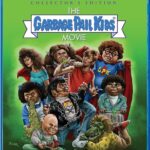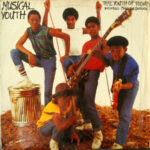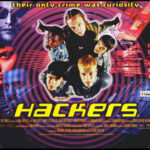 The 1980s were a golden era for pop culture, known for its unabashed embrace of the quirky, the colorful, and the downright weird. Amid this cultural explosion, The Garbage Pail Kids emerged as a phenomenon. Originally a line of collectible trading cards parodying the wholesome Cabbage Patch Kids dolls, the cards became a pop culture staple, adored by children and loathed by parents for their gross-out humor and rebellious spirit.
The 1980s were a golden era for pop culture, known for its unabashed embrace of the quirky, the colorful, and the downright weird. Amid this cultural explosion, The Garbage Pail Kids emerged as a phenomenon. Originally a line of collectible trading cards parodying the wholesome Cabbage Patch Kids dolls, the cards became a pop culture staple, adored by children and loathed by parents for their gross-out humor and rebellious spirit.
Inevitably, Hollywood decided to capitalize on the success of the cards with a feature film. The result, 1987’s The Garbage Pail Kids Movie, is widely regarded as one of the worst films ever made—a bizarre and baffling cinematic misstep that failed to capture the charm of its source material. Over three decades later, the movie remains a cautionary tale of misguided ambition and creative confusion.
In this article, we’ll explore the origins of the Garbage Pail Kids, the making of the film, its reception, and why it has endured as a cult classic for all the wrong reasons.
The Garbage Pail Kids: From Cards to Cultural Phenomenon
Topps, the company behind the Garbage Pail Kids trading cards, struck gold in 1985 when the cards hit store shelves. Created by cartoonist Art Spiegelman (who would later win a Pulitzer Prize for Maus) and Mark Newgarden, the cards featured grotesque, satirical characters with names like “Adam Bomb,” “Leaky Lindsay,” and “Up Chuck.” Each card depicted a character with a disgusting or absurd attribute, often engaging in outlandish antics.
The cards were an instant hit with kids, who relished their irreverence and gross-out humor. Parents and teachers, however, were less enthusiastic, often banning the cards in schools for being disruptive and inappropriate. The controversy only fueled their popularity, and by 1987, Garbage Pail Kids had become a cultural phenomenon.
Hollywood executives, sensing an opportunity to cash in on the craze, quickly set their sights on bringing the cards to the big screen.
The Making of the Movie: A Perfect Storm of Bad Decisions
The Garbage Pail Kids Movie was directed by Rod Amateau, a veteran of television comedies like The Many Loves of Dobie Gillis. Despite his experience, Amateau seemed ill-equipped to handle the challenges of adapting the irreverent, anarchic spirit of the trading cards into a cohesive film.
1. The Plot
The movie’s plot, such as it is, centers around Dodger, a plucky teenage boy who works at an antique shop owned by the eccentric Captain Manzini. One day, Dodger accidentally opens a mysterious garbage pail, unleashing the titular Garbage Pail Kids—seven bizarre, grotesque creatures with names like Valerie Vomit, Greaser Greg, and Messy Tessie.
The Kids help Dodger stand up to local bullies and pursue his crush, Tangerine, while dodging a sinister State Home for the Ugly, a government facility that imprisons people deemed unattractive. Yes, you read that correctly.
2. The Puppets
The Garbage Pail Kids were brought to life using animatronic puppets designed by makeup effects artist John Carl Buechler. While ambitious in concept, the execution was deeply flawed. The puppets’ facial expressions were stiff and unsettling, with jerky movements and dead, glassy eyes that gave them an uncanny valley quality.
The puppetry was so poor that it became a major distraction, making it difficult for audiences to connect with the characters. Instead of being endearing or funny, the Kids came across as creepy and off-putting.
3. Tone and Humor
One of the film’s biggest missteps was its inability to decide on a target audience. While the trading cards were clearly aimed at children, the movie contained inappropriate humor, including crude jokes, innuendos, and surprisingly dark themes. This tonal inconsistency alienated both children and adults, leaving the film in a no-man’s-land of awkwardness.
The Reception: Critical and Commercial Disaster
When The Garbage Pail Kids Movie was released in August 1987, it was met with near-universal scorn from critics and audiences alike.
1. Critical Reviews
The reviews were brutal. Critics lambasted the film for its incoherent plot, unlikable characters, and grotesque visuals. Roger Ebert famously gave the film a half-star review, calling it “one of the most unpleasant, misguided films I’ve ever seen.”
The film’s attempts at humor were particularly criticized, with many noting that the jokes fell flat and often veered into mean-spirited territory. What was meant to be a playful gross-out comedy instead came across as crass and charmless.
2. Box Office Performance
Unsurprisingly, the movie was a commercial flop. Produced on a budget of $1 million, it earned less than $2 million at the box office, failing to recoup its costs. The poor performance effectively killed any plans for a sequel or further adaptations of the Garbage Pail Kids franchise.
Why Was the Movie So Bad?
The failure of The Garbage Pail Kids Movie can be attributed to several key factors:
1. Misunderstanding the Source Material
The trading cards worked because they were short, punchy, and irreverent. They relied on visual gags and clever wordplay, qualities that don’t easily translate into a feature-length narrative. The film’s attempt to stretch the concept into a coherent story resulted in a plodding, nonsensical plot that lacked the wit and charm of the cards.
2. Poor Production Values
The film’s low budget was painfully evident in every aspect of its production, from the cheap sets to the poorly executed puppetry. Instead of feeling like a playful, anarchic romp, the movie came across as amateurish and hastily thrown together.
3. Tonal Confusion
By trying to appeal to both children and adults, the film ended up pleasing neither. Its crude humor and unsettling visuals alienated young audiences, while its simplistic story and juvenile jokes failed to engage adults.
The Cult Following: So Bad It’s Good?
Despite—or perhaps because of—its many flaws, The Garbage Pail Kids Movie has developed a cult following over the years. Fans of bad cinema have embraced the film as a prime example of “so bad it’s good” entertainment, reveling in its awkward performances, bizarre dialogue, and overall ineptitude.
Screenings of the movie have become a staple of midnight movie marathons, where audiences laugh at its absurdity and quote its most ridiculous lines. In this context, the film’s failure has become its greatest strength, turning it into an unintentionally hilarious comedy.
Legacy: A Warning and a Curiosity
While the Garbage Pail Kids trading cards remain a beloved relic of 1980s pop culture, the movie serves as a cautionary tale about the perils of cashing in on a trend without fully understanding its appeal.
In the years since its release, The Garbage Pail Kids Movie has been referenced and parodied in countless discussions about bad movies. It occupies a unique place in cinematic history as a film so bizarre and misguided that it’s impossible to forget.
Conclusion: A Beautiful Disaster
The Garbage Pail Kids Movie is not just a bad film—it’s a fascinating cultural artifact that embodies the excesses and absurdities of its time. While it failed as an adaptation and as a piece of entertainment, it succeeded in carving out a lasting legacy as one of the weirdest, most inexplicable movies ever made.
For fans of the strange and the offbeat, The Garbage Pail Kids Movie remains a must-watch—if only to marvel at how spectacularly wrong it went.
This post has already been read 200 times!









